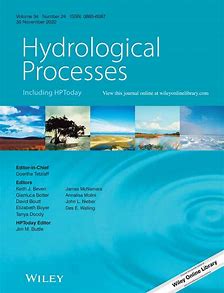- Topic:Freshwater ecosystems
Visualizing catchment-scale spatio-temporal dynamics of storage-flux-age interactions using a tracer-aided ecohydrological model
The authors used a tracer-aided ecohydrological model to quantify changes in water flux, storage, and age to improve understanding of spatial differences in catchment response through wet and dry cycles. The visualization tool revealed interannual changes in catchment-scale vegetation water usage and water ages and independent effects on individual species and responses / resilience to droughts.
From meta-system theory to the sustainable management of rivers in the Anthropocene
Most existing river conservation, restoration, and biomonitoring practices focus on local-scale strategies and measures. To improve the management of river networks in the Anthropocene, the authors suggest additional metrics and assessment approaches that incorporate regional processes more effectively.
Characterizing the “fungal shunt”: parasitic fungi on diatoms affect carbon flow and bacterial communities in aquatic microbial food webs
The study demonstrates that parasitic fungi profoundly modify microbial interactions through several mechanisms (e.g., stimulating bacterial colonization on phytoplankton cells, altering the community composition of bacteria). Hence, fungal microparasites can substantially shape the microbially mediated carbon flow at the base of aquatic food webs which we termed "fungal shunt" .
From microbes to mammals: agriculture homogenizes pond biodiversity across different land-use types
The team investigated the aquatic biodiversity in ponds located in different land-use types embedded in an agricultural area. Intensive agriculture erased most differences in aquatic biodiversity between grasslands, forests, and arable fields across all species from microbes to large organisms. Sediments, serveing as a biodiversity archive, reveal that such differences occured in the area.
A novel measurement-based model for calculating O2 flux at interfaces in aquatic environments
This study presents a novel model approach for diffusive fluxes of dissolved gases, nutrients, and solutes from concentration profiles measured across the substrate-water interfaces using microsensors. The model offers a robust computational scheme for automatized determination of the interface position and enables precise calculations of the interfacial diffusive fluxes simultaneously.
Phylogenomic insights into the origin of primary plastids
Did primary plastids originate by a single or multiple endosymbiosis events between a heterotrophic host eukaryote and cyanobacteria? By using a phylogenomic approach to untangle the diversification of the primary plastid-bearing lineages (Archaeplastida), the authors propose a single endosymbiosis but highlight and discuss the affiliation of the plastid-lacking Picozoa to the Archaeplastida.
PhyloFisher: a phylogenomic package for resolving eukaryotic relationships
The authors developed a user-friendly software tool (“PhyloFisher”) for phylogenomic analyses of eukaryotes. This software package aids in the construction and curation of protein sequence-based datasets, conducts post-assembly analyses, and allows visualisation of the results.
An automatic method to detect lake ice phenology using MODIS daily temperature imagery
The authors developed a new method of satellite data processing for lake ice determination and applied it to investigation of ice regime on Chinese lakes. The method allowed to obtain estimates of the climate driven trends in ice phenology including the duration of transitional periods of partial ice coverage.
The lake ice continuum concept: influence of winter conditions on energy and ecosystem dynamics
The authors combined current literature with three novel case studies – one of them Lake Stechlin - to develop the Lake Ice Continuum Concept to understand how key aspects of the physical, chemical, and ecological structure and function of lakes vary along a continuum of energy inputs mediated by winter climate. This framework is useful for predicting how lakes respond to climate change.
Abundance and biogeography of methanogenic and methanotrophic microorganisms across European streams
The authors aimed at describing community composition of methanogenic and methanotrophic microorganisms at large spatial scale and at linking their abundances to potential sediment methane production and oxidation rates. Diversity of methanogenic archaea was higher in warmer streams and diversity of methanotrophic communities was higher at southern sampling sites and in larger streams.











